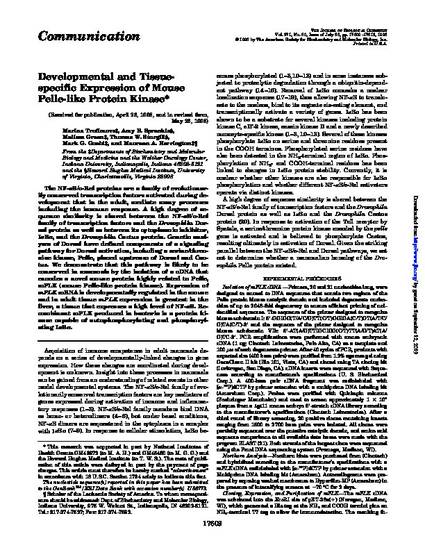
Article
Developmental and Tissue-specific Expression of Mouse Pelle-like Protein Kinase
Journal of Biological Chemistry
(1996)
Abstract
The NF-kappaB/c-Rel proteins are a family of evolutionarily conserved transcription factors activated during development that in the adult, mediate many processes including the immune response. A high degree of sequence similarity is shared between the NF-kappaB/c-Rel family of transcription factors and the Drosophila Dorsal protein as well as between its cytoplasmic inhibitor, IkappaBalpha, and the Drosophila Cactus protein. Genetic analyses of Dorsal have defined components of a signaling pathway for Dorsal activation, including a serine/threonine kinase, Pelle, placed upstream of Dorsal and Cactus. We demonstrate that this pathway is likely to be conserved in mammals by the isolation of a cDNA that encodes a novel mouse protein highly related to Pelle, mPLK (mouse Pelle-like protein kinase). Expression of mPLK mRNA is developmentally regulated in the mouse and in adult tissue mPLK expression is greatest in the liver, a tissue that expresses a high level of NF-kappaB. Recombinant mPLK produced in bacteria is a protein kinase capable of autophosphorylating and phosphorylating IkappaBalpha.
Disciplines
Publication Date
July 26, 1996
DOI
10.1074/jbc.271.30.17609
Citation Information
Marina Trofimova, Amy B. Sprenkle, Melissa Green, Thomas W. Sturgill, et al.. "Developmental and Tissue-specific Expression of Mouse Pelle-like Protein Kinase" Journal of Biological Chemistry Vol. 271 Iss. 30 (1996) p. 17609 - 17612 Available at: http://works.bepress.com/amy-sprenkle/3/